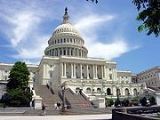
legislature
of the federal government
of the United States
, consisting of the Senate
and the House of Representatives
. The Congress meets in the United States Capitol
in Washington, D.C.
Both senators and representatives are chosen through direct election
. Each of the 435 members of the House of Representatives represents a district
and serves a two-year term. House seats are apportioned
among the states
by population. Each state, regardless of population, has two senators; since there are fifty states, there are one hundred senators who serve six-year terms. The terms are staggered, so every two years, approximately one-third of the Senate is up for election.
1775 The United States Congress adopts the Olive Branch Petition.
1789 The United States Congress passes the Judiciary Act which creates the office of the United States Attorney General and the federal judiciary system, and orders the composition of the Supreme Court of the United States.
1800 The United States Congress holds its first session in Washington, D.C.
1818 The United States Congress adopts the flag of the United States with 13 red and white stripes and one star for each state (then 20).
1820 The U.S. Congress passes the Missouri Compromise.
1846 The Smithsonian Institution is chartered by the United States Congress after James Smithson donates $500,000.
1861 American Civil War: The United States Congress passes the Crittenden-Johnson Resolution, stating that the war is being fought to preserve the Union and not to end slavery.
1865 American Civil War: The United States Congress passes the Thirteenth Amendment to the Constitution of the United States, abolishing slavery, submitting it to the states for ratification.
1866 The United States Congress passes legislation authorizing the five-star rank of General of the Army. Lieutenant General Ulysses S. Grant becomes the first to be promoted to this rank.
1900 The Congress passes the Foraker Act, giving Puerto Rico limited self-rule.

